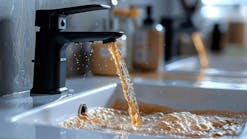Faucets and fittings are highly regulated in the U.S. and Canada. The multiple codes, standards and registration programs, most of which are mandatory, result in a long list of abbreviations that appear on products or product packaging: IPC, UPC, NSPC, NPCC, NSF, ASME, CSA and CEC. Beyond that, many states and cities operate their own registration programs, which require manufacturers to show proof of product compliance and pay a fee.
The regulations mostly flow from the local plumbing codes that operate at the state and provincial levels, but sometimes they can be at the county or city level. There are approximately 44,000 plumbing jurisdictions in the U.S. and Canada.
The National Plumbing Code of Canada includes product and installation requirements, which are enforced by plumbing inspectors in Canada’s provinces and territories. In the U.S., there are three model plumbing codes: the International Plumbing Code, the National Standard Plumbing Code and the Uniform Plumbing Code. Most jurisdictions adopt one of these codes, sometimes with additions or deviations, while some states, like Massachusetts, have developed their own codes.
The model codes identify product standards and require products like faucets to be tested and certified by accredited organizations. Standards required by the plumbing codes for faucets include ASME A112.18.1/CSA B125 – Plumbing Supply Fittings, NSF/ANSI Standard 61: Drinking Water System Components – Health Effects, and NSF/ANSI Standard 372: Drinking Water System Components – Lead Content.
Plumbing Code Requirements
ASME A112.18.1 and CSA B125 include design and performance requirements and test procedures. These standards contain one set of identical requirements for plumbing supply fittings across the U.S. and Canada. Requirements for faucets include corrosion, adhesion and abrasion tests for external coatings. Faucets must meet minimum and maximum flow rates, and undergo pressure testing and lifecycle testing on valves, swing spouts and hoses. Faucets also must meet backflow prevention criteria by employing a suitable air gap between the spout and the basin flood level. If the faucet has a side-spray, pull-out or pull-down spout, it must include acceptable backflow prevention devices, as well.
Health Effects
NSF/ANSI 61 addresses the health effects of materials in contact with drinking water in water treatment and distribution products. It covers all products with drinking water contact from source to tap. The standard establishes criteria to evaluate the amount of any chemical contaminant added from a product to drinking water. NSF/ANSI 61 asks which contaminants migrate from the product into drinking water and if those contaminants are below acceptable levels.
The standard requires a formulation disclosure by the manufacturer so chemical contaminants of concern can be identified. Faucets are exposed to test water formulated to extract contaminants from the product over a 19-day period. The exposure water then is analyzed for contaminants, and contaminant levels are compared to the single product allowable concentrations of NSF/ANSI 61 for regulated and unregulated contaminants.
A Closer Look at Lead
Lead receives special attention. Water samples are collected from three faucets at nine sample points over a 19-day period. A statistical Q value represents the dose of lead in micrograms. Faucets must be at or below 5 µg of lead to pass the test. Other U.S. Environmental Protection Agency (EPA)-regulated contaminants like arsenic or copper must be one-tenth of the maximum contaminant level. Annex A of NSF/ANSI 61 contains toxicological risk assessment criteria to derive single product allowable concentrations for unregulated contaminants.
In 2014, Safe Drinking Water Act updates required products that convey or dispense drinking water to contain a weighted average lead content of 0.25% or less. NSF/ANSI 372 establishes test criteria to verify the lead content of a product based on the lead content and relative wetted surface area of each component. It is a mandatory part of NSF/ANSI 61, which is a mandatory requirement for faucets in ASME A112.18.1/CSA B125.1.
Conservation Standards for Faucets
In addition to the U.S. federal law for lead content, federal regulations through the Department of Energy (DOE) address water conservation requirements. Residential faucets must have a maximum flow rate of 2.2 gal per minute (gpm), high-efficiency lavatory faucets must have a maximum flow rate of 1.5 gpm, and public lavatory faucets must have a maximum flow rate of 0.5 gpm.
Additionally, EPA runs a voluntary certification program called WaterSense, which covers lavatory faucets, toilets, pre-rinse spray valves, irrigation controllers, urinals and showerheads. The California Energy Commission (CEC) established water conservation requirements with substantial fines in response to an unprecedented drought in that state. Table 1 compares the maximum flow rate requirements for faucets under DOE, CEC, WaterSense and ASME/CSA.
Product Testing & Facility Audits
When NSF Intl. certifies products, the process includes initial and annual inspections of manufacturing facilities to verify that products are made of authorized components using the same processes every day. Any change to the components or manufacturing process for a certified product requires advance notification to NSF so the changes can be reviewed to determine if additional testing is required.
Samples also are retested to verify products are still in compliance with the standard. This is important in today’s marketplace, where supply chains can be lengthy and component materials may be changed at some point in the chain without the faucet company being aware.
Products that meet the requirements of the standard are certified by NSF and may bear the NSF label. Certified products appear in NSF online listings, which are available at www.nsf.org.
COPYRIGHT: (FROM LEFT) zstockphotos, hxdbzxy, loganban/123RF STOCK PHOTO



